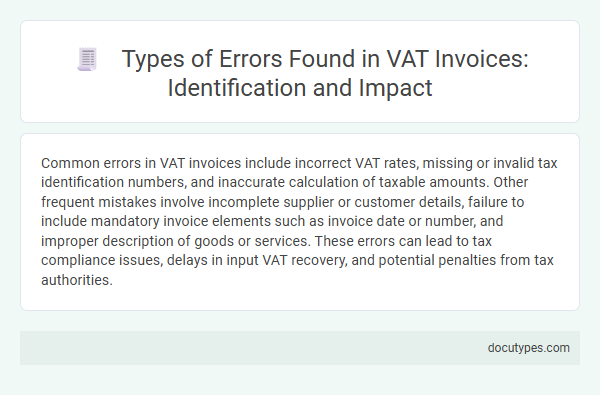Common errors in VAT invoices include incorrect VAT rates, missing or invalid tax identification numbers, and inaccurate calculation of taxable amounts. Other frequent mistakes involve incomplete supplier or customer details, failure to include mandatory invoice elements such as invoice date or number, and improper description of goods or services. These errors can lead to tax compliance issues, delays in input VAT recovery, and potential penalties from tax authorities.
Common VAT Calculation Mistakes
Errors in VAT invoices can significantly impact financial records and tax compliance. Common mistakes often involve inaccuracies in VAT rate application and miscalculations of tax amounts.
Incorrectly applying VAT rates leads to undercharging or overcharging tax, resulting in potential penalties. Miscalculations frequently occur when totals are not properly summed or tax is calculated on incorrect base amounts.
Incorrect or Missing Invoice Numbers
Incorrect or missing invoice numbers are common errors in VAT invoices that can lead to compliance issues and delayed payments. Such mistakes hinder accurate tracking and reconciliation of transactions, affecting both your accounting records and tax reporting. Ensuring every VAT invoice has a unique and correctly assigned invoice number is essential for maintaining proper financial documentation.
Errors in Buyer or Seller Details
Errors in buyer or seller details on VAT invoices commonly include incorrect names, addresses, or VAT registration numbers. Such inaccuracies can lead to rejected tax claims or delays in processing returns. Ensuring precise and verified information is essential to maintain compliance and avoid financial penalties.
Misstated VAT Rates
Errors in VAT invoices can lead to significant compliance issues and financial discrepancies. One common problem is the misstated VAT rates, which can affect the accuracy of your tax reporting and payment obligations.
- Incorrect VAT Percentage - Applying a VAT rate that does not correspond to the product or service category can result in overcharging or undercharging VAT.
- Outdated VAT Rates - Using VAT rates that have been changed due to updated tax laws causes invoices to reflect inaccurate tax amounts.
- Misclassification of Goods or Services - Assigning an incorrect VAT rate by misclassifying items leads to errors in the total VAT calculated on the invoice.
Omissions of Required Legal Information
VAT invoices must include specific legal information to ensure compliance with tax regulations. Omissions of this required information can lead to significant errors, affecting the invoice's validity.
Common omissions include missing supplier or customer VAT identification numbers, incorrect invoice date, and absence of detailed descriptions of goods or services supplied. Failure to provide the total VAT amount or the applicable VAT rate also constitutes a critical error. These omissions may result in penalties, delayed tax refunds, or rejection of the invoice by tax authorities.
Inaccurate Descriptions of Goods or Services
| Error Type | Description | Impact on VAT Invoice | Example |
|---|---|---|---|
| Inaccurate Descriptions of Goods or Services | Mismatched, vague, or incorrect details regarding the nature, quantity, or specifications of the billed goods or services. | Leads to disputes over taxable items, incorrect VAT calculation, compliance issues with tax authorities, and potential financial penalties. | Listing "Electronic equipment" instead of specifying "5 units of 32GB USB flash drives" causes unclear tax treatment and audit complications. |
Incorrect Invoice Dates
Incorrect invoice dates are a common error in VAT invoices that can affect tax reporting and compliance. Ensuring accurate invoice dates is essential for proper VAT calculations and legal adherence.
- Misdated Invoices - An invoice date that does not reflect the actual transaction date can lead to incorrect VAT periods being reported.
- Future Dates - Invoices dated in the future are invalid and can trigger audits or penalties from tax authorities.
- Backdated Invoices - Using past dates to alter the invoice timing may result in compliance breaches and legal consequences.
Verifying and correcting invoice dates helps maintain accurate VAT records and avoids regulatory issues.
Currency and Exchange Rate Errors
Errors in VAT invoices often arise due to incorrect currency specification or exchange rate application. These mistakes can lead to inaccurate tax calculations and compliance issues.
- Incorrect Currency Code - Using the wrong ISO currency code on a VAT invoice can cause financial discrepancies and confusion during cross-border transactions.
- Misapplied Exchange Rate - Applying an outdated or incorrect exchange rate can distort the VAT amount, leading to underpayment or overpayment of tax liabilities.
- Missing Currency Conversion Details - Failure to include the exchange rate date and source on your VAT invoice reduces transparency and complicates audit verification.
Duplicate Invoices
Duplicate invoices are a common error in VAT invoicing that can lead to significant accounting discrepancies. These occur when the same invoice is submitted multiple times for the same transaction.
Duplicate invoices can cause incorrect VAT claims and potentially trigger audits or penalties from tax authorities. You should implement systematic checks to identify and prevent duplicates in your invoicing process.
What Types of Errors Can Occur in VAT Invoices? Infographic

